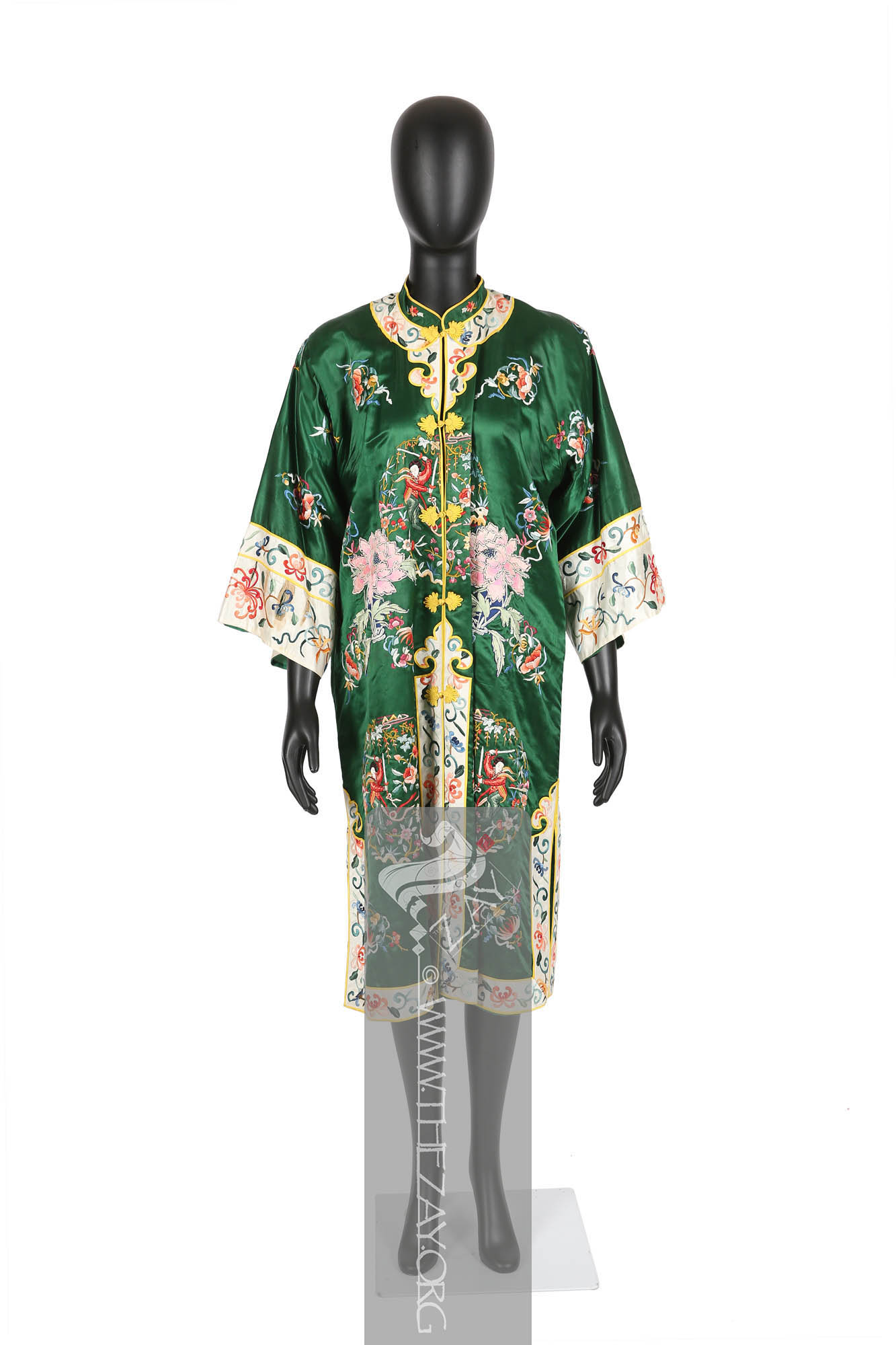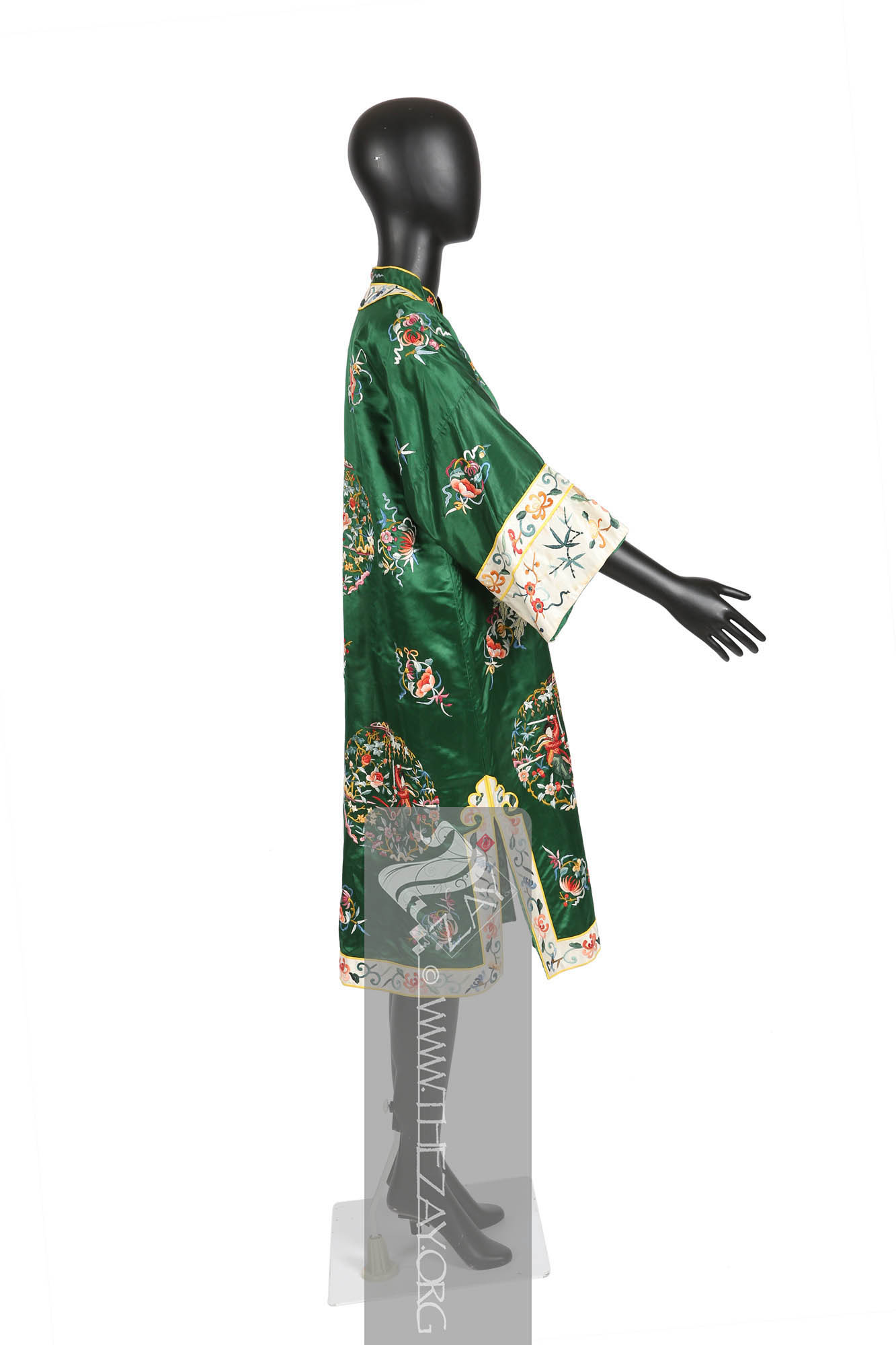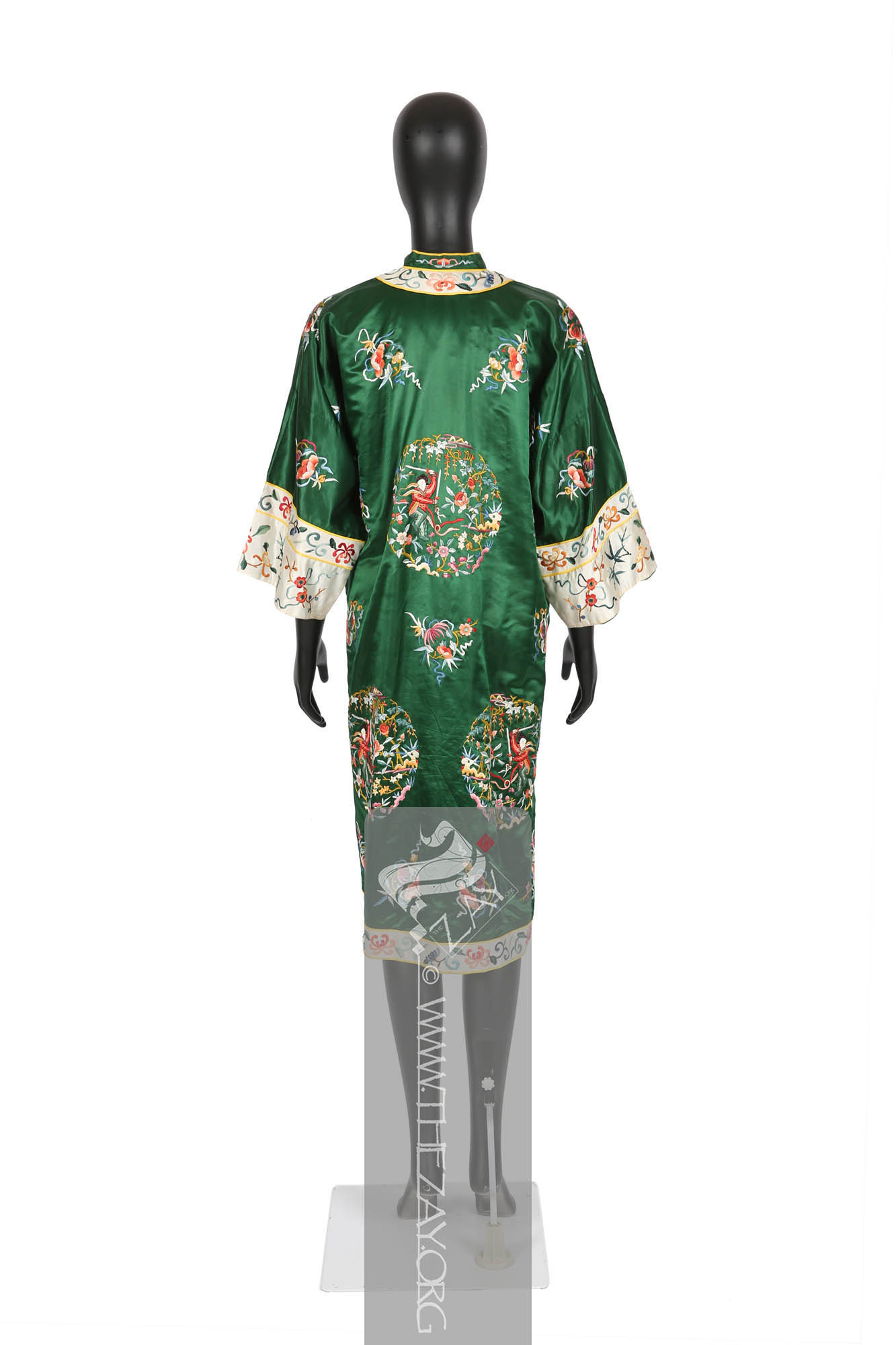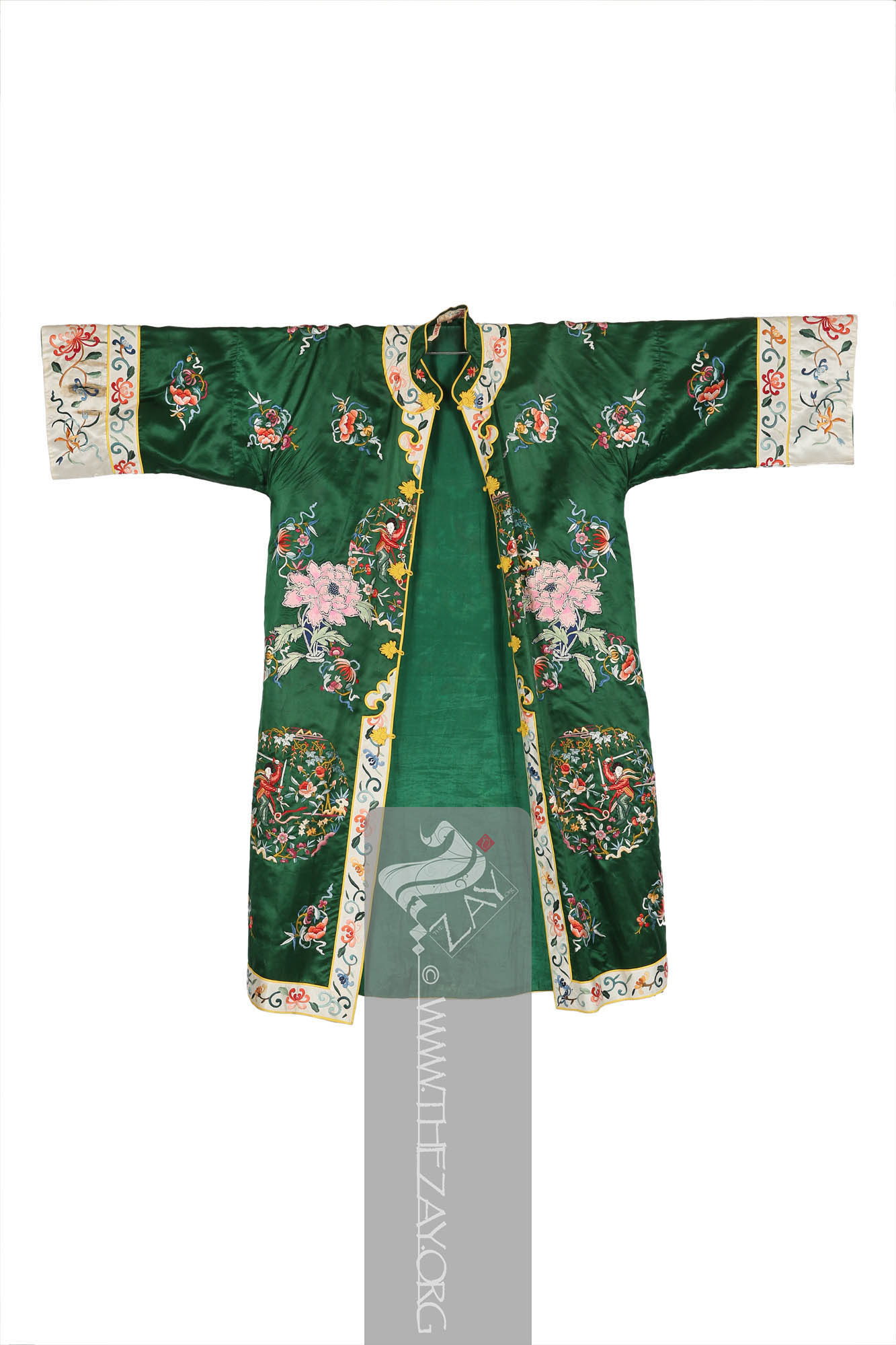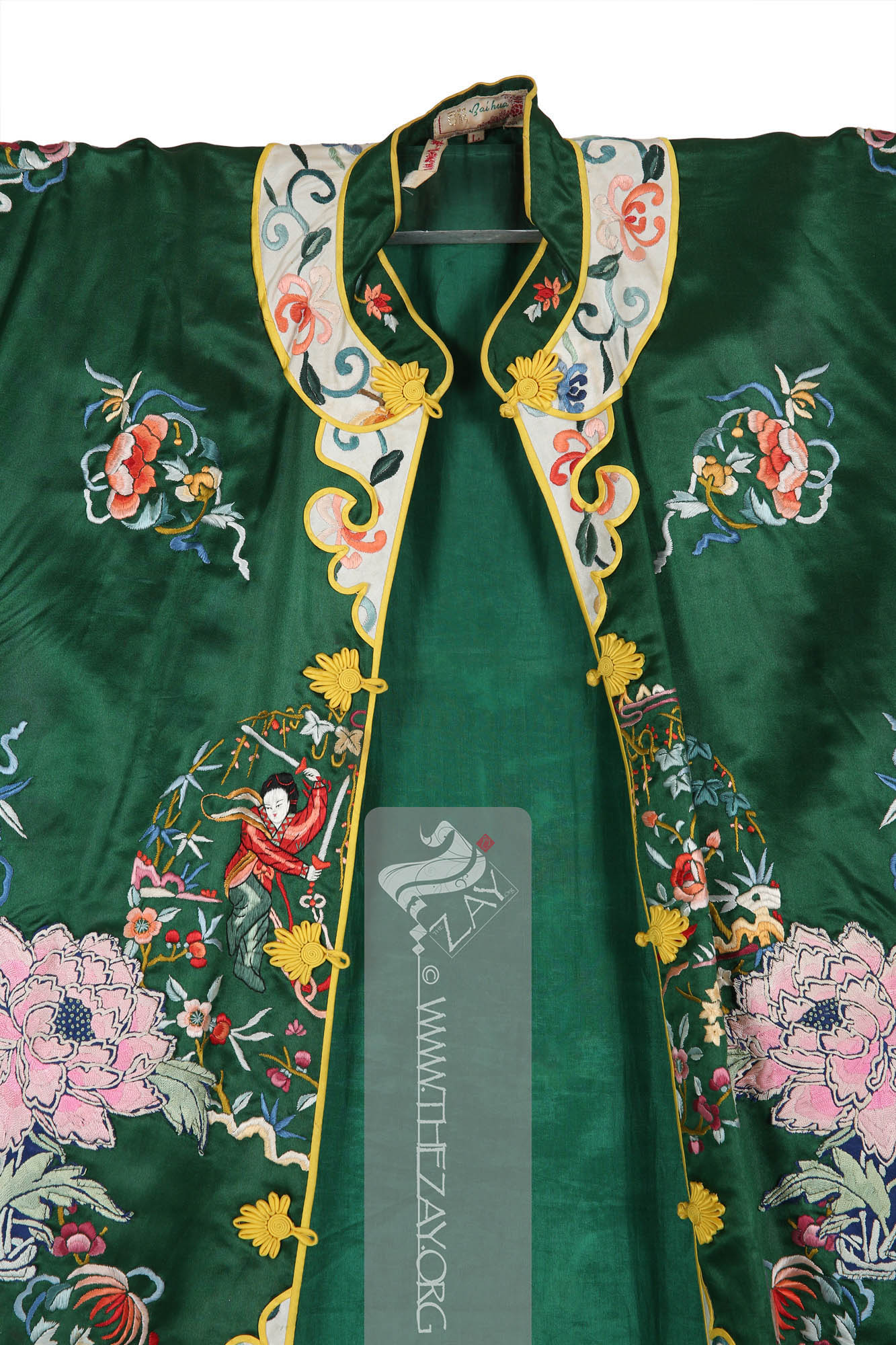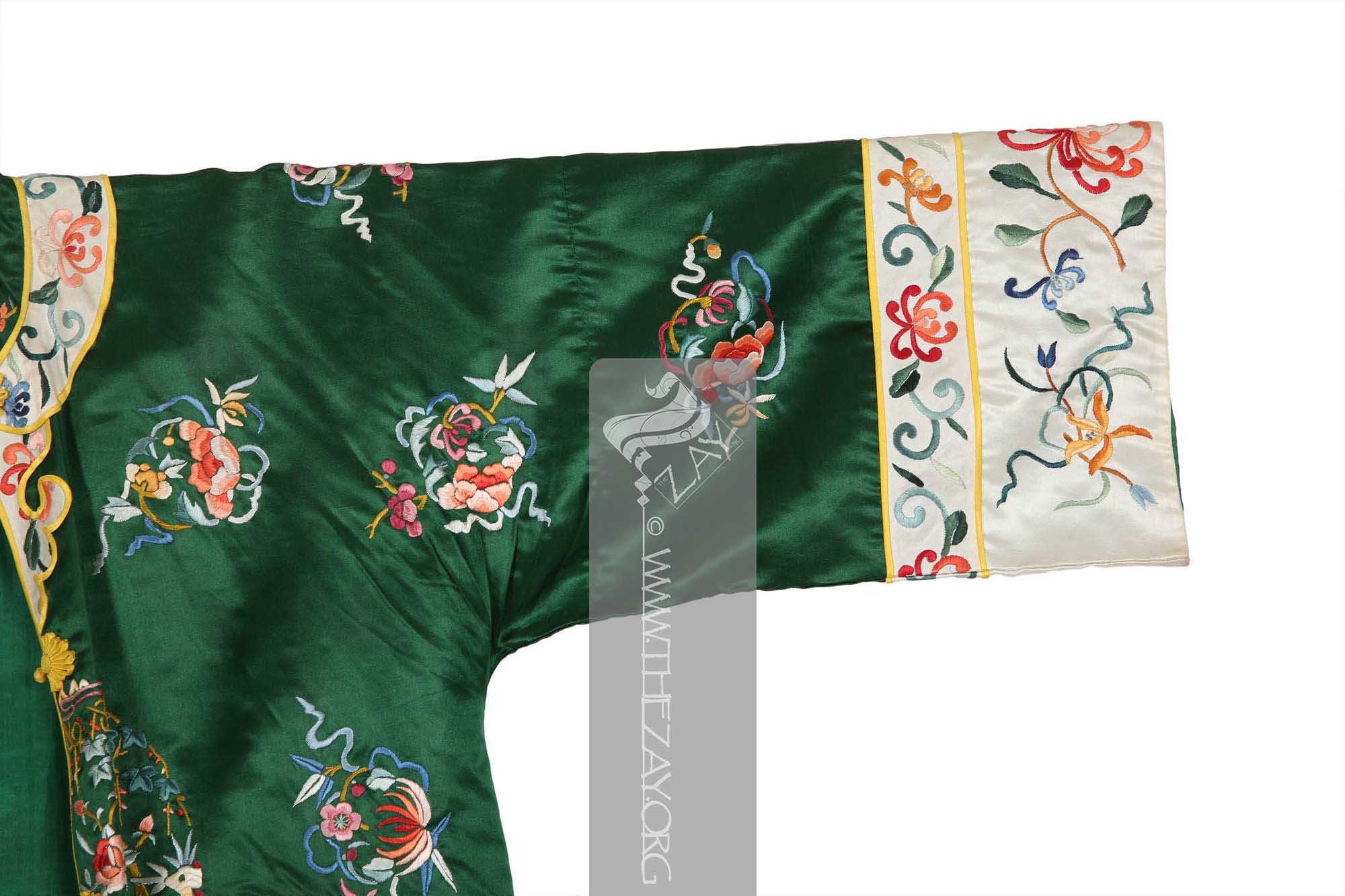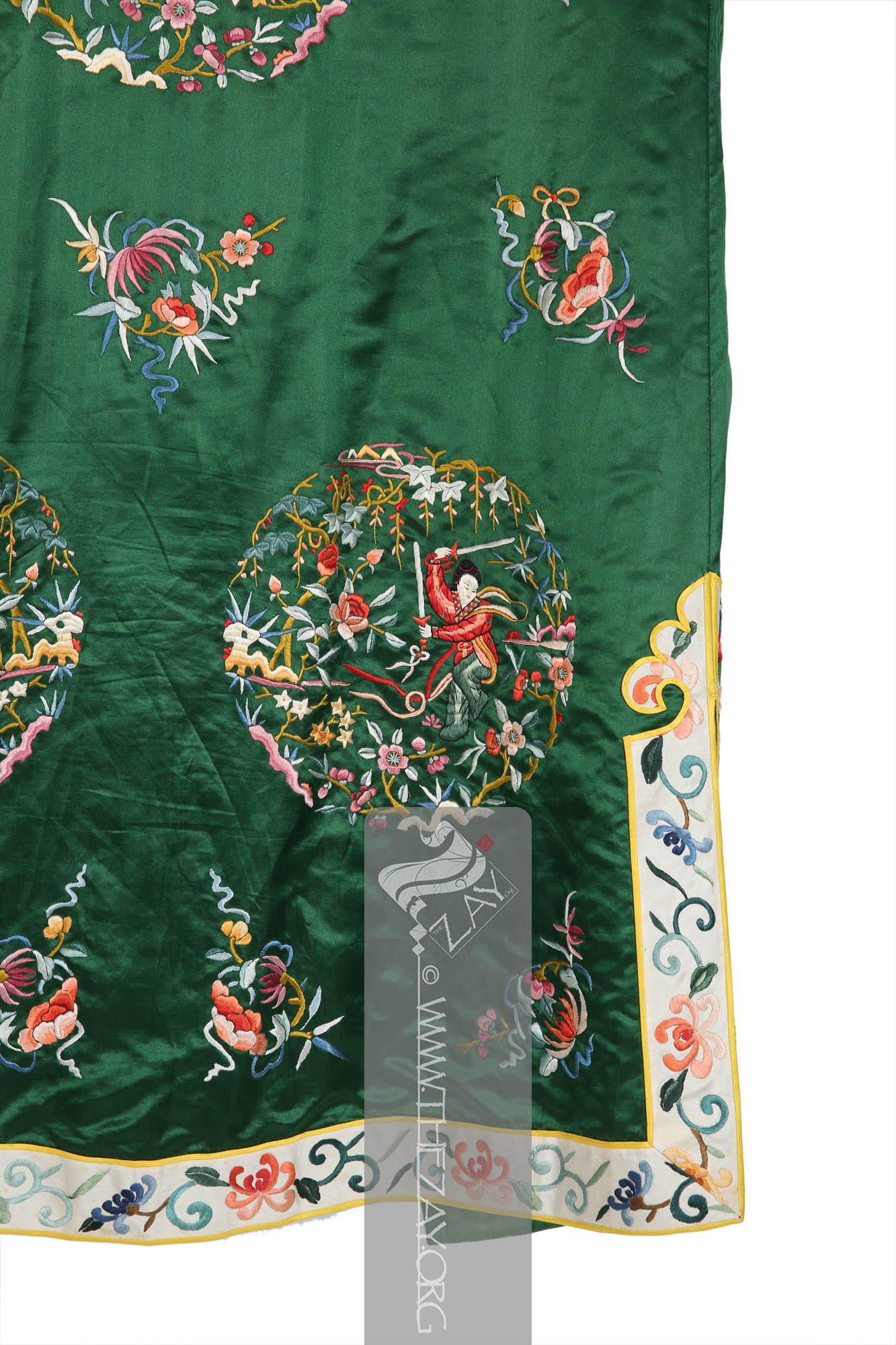Object HistoryPurchased by
Dr. Reem Tariq
Ṭariq: (Arabic; Synonym: tulle_bi_talli; talli; badla; khus_dozi ), series of small metal knots made on a woven net ground as embellishment. The term is commonly used in the Levant Arab region specifically in Lebanon.
El Mutwalli
Dr. Reem Tariq
Ṭariq: (Arabic; Synonym: tulle_bi_talli; talli; badla; khus_dozi ), series of small metal knots made on a woven net ground as embellishment. The term is commonly used in the Levant Arab region specifically in Lebanon.
el Mutwallī: Founder (CEO) of the Zay
Zay: (Arabic: costume, Pl. azyaā’), a set of clothes in a style typical of a particular country or historical period. Initiative, a public figure, speaker and author. An expert curator and consultant in Islamic art and architecture, interior design, historic costume, and UAE heritage. in 2015, from an antique dealer in China.
Object Features This is an emerald green (
cheongsam
Cheongsam: (From Cantonese: chèuhngsāam; from Shanghainese: zansae – Long shirt or dress; Synonym – Qipao
Qipao: (Synonym – cheongsam), meaning ‘Banner robes’ were originally traditional Manchu long loose robes worn over trousers. In the early 20th century, it morphed into its present form and incorporated Western style in the 1920s and became interchangeable with a cheongsam. ), was originally a traditional Chinese long gown with high collars and a form-fitting silhouette. It morphed into its present form in the early 20th century and incorporated Western style in the 1920s and became interchangeable with a qipao
Qipao: (Synonym – cheongsam), meaning ‘Banner robes’ were originally traditional Manchu long loose robes worn over trousers. In the early 20th century, it morphed into its present form and incorporated Western style in the 1920s and became interchangeable with a cheongsam. . )/(
qipao
Qipao: (Synonym – cheongsam), meaning ‘Banner robes’ were originally traditional Manchu long loose robes worn over trousers. In the early 20th century, it morphed into its present form and incorporated Western style in the 1920s and became interchangeable with a cheongsam. ) style shirt of (
rayon
Rayon: a semi-synthetic fabric made from cellulose fibers derived from wood pulp. It was first produced in the late 19th century as an alternative to silk. Rayon became popular due to its softness, drapability, and affordability, and it is used in a wide range of clothing and home decor applications. ) – a semi-synthetic plant-based fibre also called artificial silk – in the (
satin
Sātin: (Arabic: Zaytuni: from Chinese port of Zayton in Quanzhou province where it was exported from and acquired by Arab merchants), one of the three basic types of woven fabric with a glossy top surface and a dull back. Originated in China and was fundamentally woven in silk.) weave. It is embellished with (
satin_stitch
Satin_stitch: (Synonym: Damask Stitch), is a type of flat embroidery stitch that creates a satin like smooth and shiny surface by closely spaced stitches, covering an entire area or shape.) embroidery done on the machine all over with floral and figured motifs in an array of coloured silk
floss
Floss: (Old French: flosche – nap of velvet), is a type of silk fibre obtained from the cocoons of wild silkworms. It is characterized by its long, fluffy fibers that are not tightly woven, making it ideal for use in various textile applications such as embroidery, lace-making, and sewing. threads.
With the ivory fabric of similar
satin
Sātin: (Arabic: Zaytuni: from Chinese port of Zayton in Quanzhou province where it was exported from and acquired by Arab merchants), one of the three basic types of woven fabric with a glossy top surface and a dull back. Originated in China and was fundamentally woven in silk. weave sleeve bands, collars, and fall, the piece has a bright yellow fabric (
appliqued
Appliqued: (French: appliquer – Apply), ornamental needlework where small pieces of decorative fabric are sewn on to a larger piece to form a pattern.) to it that acts like a border around the lapels and the hem. The same fabric is used for floral patterns (frog_fasteners) for buttons and loops.
The
satin_stitch
Satin_stitch: (Synonym: Damask Stitch), is a type of flat embroidery stitch that creates a satin like smooth and shiny surface by closely spaced stitches, covering an entire area or shape. embroidery on the piece is in a range of brightly coloured silk
floss
Floss: (Old French: flosche – nap of velvet), is a type of silk fibre obtained from the cocoons of wild silkworms. It is characterized by its long, fluffy fibers that are not tightly woven, making it ideal for use in various textile applications such as embroidery, lace-making, and sewing. thread and depicts mostly floral motifs that have deep symbolic significance in Far Eastern beliefs and philosophies like peonies, lotuses, and bamboo leaves. With two large pink peonies in full bloom flanking the two edges of the midriff close to the waist the rest of the piece is scattered with small floating lotuses in
coral
Coral: (Greek: korallion, probably from Hebrew: goral – small pebbles), is a pale to medium shade of pink with orange or peach undertones, resembling the colour of certain species of coral. with wavy foliage along with a large circular pattern or a medallion of floral arrangements with a central human figure wielding a dual sword in martial arts style.
From the figured motif it could be concluded that the piece was made for a Western market, possibly as a souvenir for those that are influenced by an aspect of Chinese pop culture that took the world by storm.
The lining of the piece is also in the same shade of emerald but in a much thinner
satin
Sātin: (Arabic: Zaytuni: from Chinese port of Zayton in Quanzhou province where it was exported from and acquired by Arab merchants), one of the three basic types of woven fabric with a glossy top surface and a dull back. Originated in China and was fundamentally woven in silk.. There is a maker’s label on the piece in both Chinese and English that reads “75%
Rayon
Rayon: a semi-synthetic fabric made from cellulose fibers derived from wood pulp. It was first produced in the late 19th century as an alternative to silk. Rayon became popular due to its softness, drapability, and affordability, and it is used in a wide range of clothing and home decor applications. and 25% Silk” which testifies to its Chinese origin and its fabric ratio.
With just a handful of countries earning mentions in the “Object range” section due to technical limitations, one must never forget the vast range of influence the Chinese culture has had across the globe especially South and Central Asia, southeast Asia, and the Middle East. As such it would not be presumptuous to categorize all the countries of these regions under this section where such a fabric likely to be easily available.
In fact, the impact of the Silk Route from China all the way across to the Middle East could perhaps very well be surmised through one word “
satin
Sātin: (Arabic: Zaytuni: from Chinese port of Zayton in Quanzhou province where it was exported from and acquired by Arab merchants), one of the three basic types of woven fabric with a glossy top surface and a dull back. Originated in China and was fundamentally woven in silk.”. A fabric that was exported from the port of Zayton in China and was acquired by the Arab traders was named after the city that it came from and was later morphed into “
satin
Sātin: (Arabic: Zaytuni: from Chinese port of Zayton in Quanzhou province where it was exported from and acquired by Arab merchants), one of the three basic types of woven fabric with a glossy top surface and a dull back. Originated in China and was fundamentally woven in silk.” by the Europeans.
Similarly, the cultural exchanges through trade relations between China and South Asia had always been quite strong so much so that religious philosophies like that of Buddhism which was essentially born in India became one of the major faiths in China since the antiquities.
While the earlier impact of Chinese culture on the West had been primarily through third parties or at best sporadically first hand, the Industrial Revolution brought in a barrage through the influx of Chinese traders and laborers travelling west and taking their culture with them.
By the second half of the 20th century, practices that were once intrinsic to Chinese culture such as traditional Chinese medicine, music, dance, drama, theatre, martial and other performing arts, crossed the oceans easily through film and other literature. Thus, it would be quite wrong to curtail the range of such a piece as this to just a few countries.
Links
- https://blogs.brown.edu/amst-1905l-s01-spring-2017/cheongsam
Cheongsam: (From Cantonese: chèuhngsāam; from Shanghainese: zansae – Long shirt or dress; Synonym – Qipao
Qipao: (Synonym – cheongsam), meaning ‘Banner robes’ were originally traditional Manchu long loose robes worn over trousers. In the early 20th century, it morphed into its present form and incorporated Western style in the 1920s and became interchangeable with a cheongsam. ), was originally a traditional Chinese long gown with high collars and a form-fitting silhouette. It morphed into its present form in the early 20th century and incorporated Western style in the 1920s and became interchangeable with a qipao
Qipao: (Synonym – cheongsam), meaning ‘Banner robes’ were originally traditional Manchu long loose robes worn over trousers. In the early 20th century, it morphed into its present form and incorporated Western style in the 1920s and became interchangeable with a cheongsam. . -then-and-now/
- https://www.metmuseum.org/art/collection/search/83978
- https://eresources.nlb.gov.sg/infopedia/articles/SIP_2013-09-27_171732.html
- http://en.chinaculture.org/library/2008-01/28/content_43933.htm
- https://www.thepankou.com/qipao
Qipao: (Synonym – cheongsam), meaning ‘Banner robes’ were originally traditional Manchu long loose robes worn over trousers. In the early 20th century, it morphed into its present form and incorporated Western style in the 1920s and became interchangeable with a cheongsam. -cheongsam
Cheongsam: (From Cantonese: chèuhngsāam; from Shanghainese: zansae – Long shirt or dress; Synonym – Qipao
Qipao: (Synonym – cheongsam), meaning ‘Banner robes’ were originally traditional Manchu long loose robes worn over trousers. In the early 20th century, it morphed into its present form and incorporated Western style in the 1920s and became interchangeable with a cheongsam. ), was originally a traditional Chinese long gown with high collars and a form-fitting silhouette. It morphed into its present form in the early 20th century and incorporated Western style in the 1920s and became interchangeable with a qipao
Qipao: (Synonym – cheongsam), meaning ‘Banner robes’ were originally traditional Manchu long loose robes worn over trousers. In the early 20th century, it morphed into its present form and incorporated Western style in the 1920s and became interchangeable with a cheongsam. . -edging/




